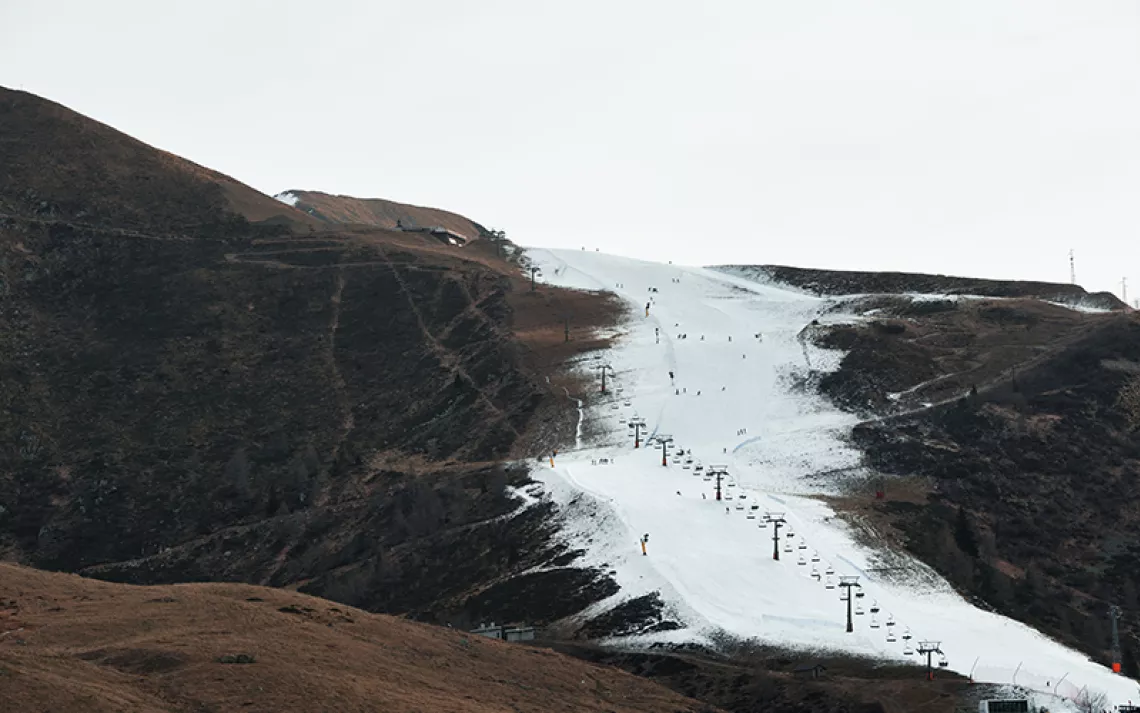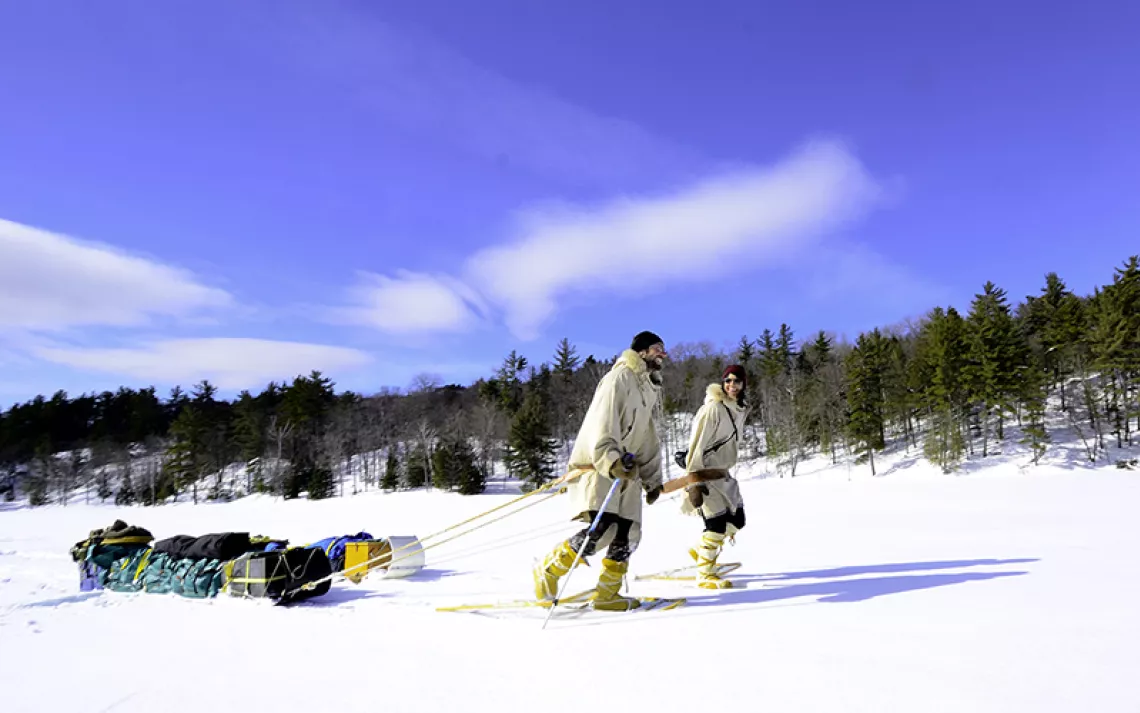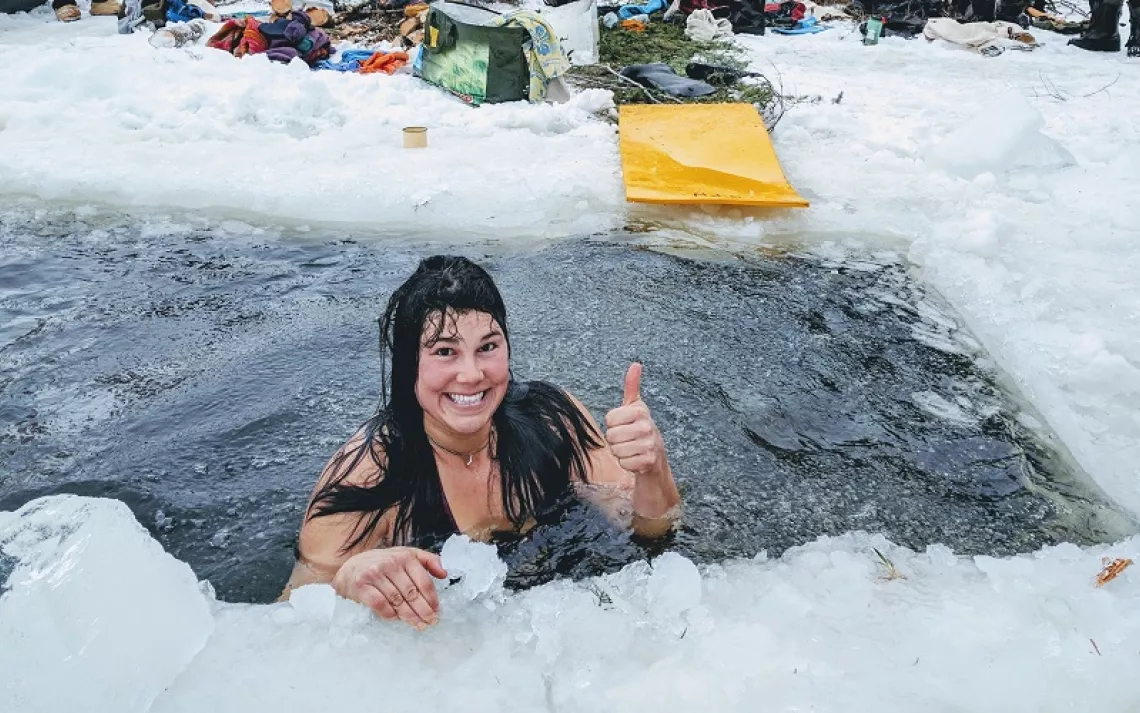Snow Monsters
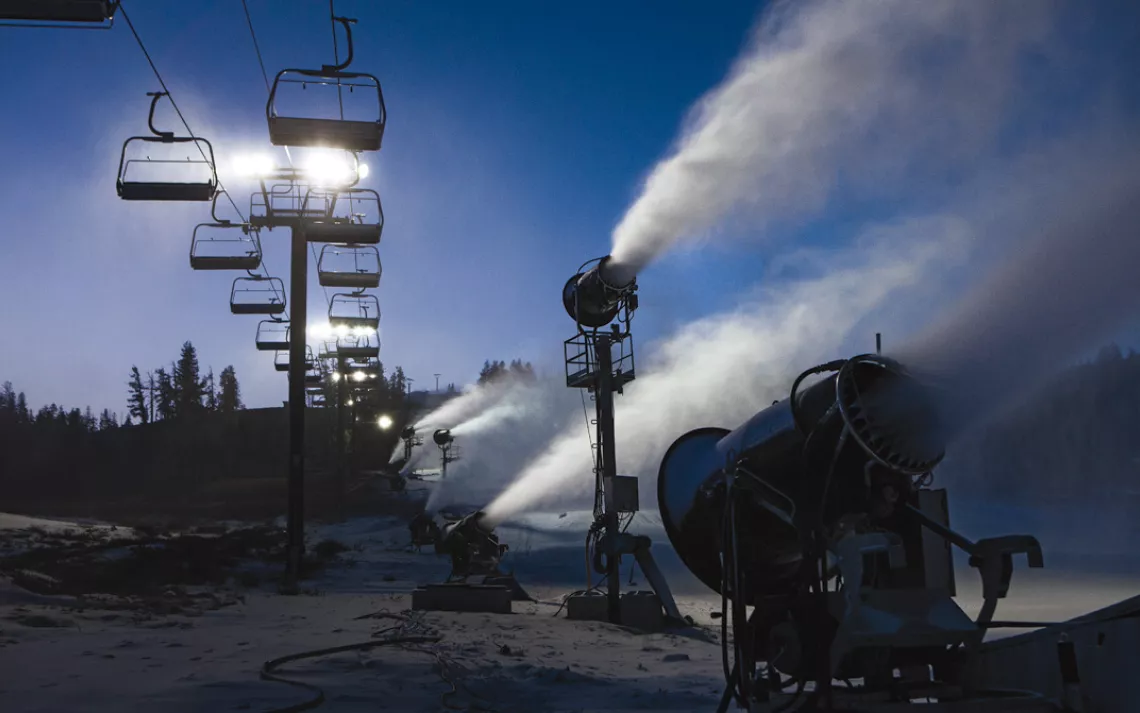
California’s Boreal Mountain Resort prepares for opening day.
|Photography by Max Whittaker/Prime
Don’t get me wrong—I live to ski. I spent my youth as a ski bum. But on a clear, cold day in December 2011, while driving the snowless, drought-choked flats between the Lake Tahoe Basin and Truckee in California’s Sierra Nevada, I glanced in my rearview mirror and was transfixed by the bizarre sight of the north-facing pistes of Northstar swathed in immaculate white. (The effect was similar to glimpsing Disneyland’s Matterhorn from Interstate 5.) Every other ski area in the region had also whipped up artificial slopes for the period between Christmas and New Year’s, which accounts for up to a quarter of a resort’s total ski-related revenues. “If you don’t get Christmas, you’re done,” says Daniel Scott, research chair on the sustainability of the ski industry at the University of Waterloo in Ontario, Canada.
When it comes to skiing, resorts have achieved the miracle of a white Christmas by artificial means as far back as the 1950s. Since then, snowmaking has become more than a mere hedge to the North American ski industry. Machine-made snow has become the industry’s salvation.
“It snows when it wants to,” reads the advertising copy from one snow-gun manufacturer. “That was true 100 years ago, and it’s still true today. What’s different is that today we expect to be able to go skiing when we want to.”
Because the onset of winter and natural snow is so unpredictable, resort owners have welcomed the ability to supplement their snowpack in the early season. According to Scott, the reliability of machine-made snow helped catalyze the hospitality industry that has grown around ski hills in the last 60 years. Thanks to snowmaking, the length of the North American ski season increased in the 1990s and 2000s (although it has declined since then).
Ski resort operators will be forced to double down on snowmaking in the coming years, Scott says. He was the lead author of a 2014 study called “The Future of the Olympic Winter Games in an Era of Climate Change,” which demonstrated that under a high-emissions climate change scenario, only 10 of the past 19 winter Olympic venues will be able to host the games in 2050. (Among those out of the running will be Vancouver, Squaw Valley, and Sochi.) In another study, Scott simulated the fate of the entire ski industry in various regions using the Intergovernmental Panel on Climate Change’s optimistic scenario of a 2°C global temperature increase. Some high-elevation resorts would survive to the end of the century, he concluded, but only with substantial investments in snowmaking. In the IPCC’s “business-as-usual” scenario of a greater than 2°C rise, the entire industry essentially folds.
Snowflakes, natural or technology-assisted, are nothing more than a mixture of water and air. You can make them at home on a cold enough day by attaching a special fitting to a common pressure washer and an air compressor. The most rudimentary guns, still widely used, do exactly that on an industrial scale, mixing compressed air and water inside their housings before broadcasting the snow onto slopes in a loud hiss. The atomized water nucleates into small kernels, which, as they hang in the air, acquire the branches that form the dendritic shape we associate with snowflakes.
Mike Kaplan, president and CEO of the Aspen Skiing Company, remembers the then-arduous drill from early in his career in the 1980s and early ’90s: attaching air and water hoses to guns on steep slopes at night in subfreezing temperatures and setting off the guns one by one. Automation has since streamlined the process; snow guns sit on towers that house weather stations, which monitor temperature, humidity, and wind speed and direction. All it takes is a push of a button in a control room when calm winds, freezing temps, and dry air combine to create ideal conditions. Similarly, “stick” guns affixed to 30-foot poles increase newborn crystals’ hang time. Highly efficient fan guns, which resemble turbojet engines, use onboard fans, minimizing or obviating the need for compressed air.
While making snow is simple physics, distributing water and compressed air from the base of a ski resort to its upper reaches requires a complex infrastructure of reservoirs, pumps, air compressors, and miles of pipes and conduits. David Kennedy, the U.S. representative of TechnoAlpin, estimates that newer, energy-efficient snow guns consume between one and two megawatt-hours per acre-foot of manufactured snow. That’s like burning about a thousand pounds of coal an hour—and less efficient snow guns can easily consume twice that. Air compression alone is the greatest energy hog; at Aspen, it accounts for 13 percent of the total energy bill. When you combine snowmaking waterworks with the carbon load of the snowcats that move machine-made snow up and down slopes, you’re talking about a hefty carbon footprint.
In 2005, Scott studied the greenhouse gas emissions of Maine’s Sunday River ski area. The resort made snow on nearly 92 percent of its 663 acres, which translated into an average of 26 million kilowatt-hours of electricity in a typical year, equivalent to the electricity used by 3,600 homes. Snowmaking accounts for 73 percent of a typical New England resort’s energy use, according to a report issued by the American Council for an Energy-Efficient Economy.
“The irony with making snow,” says Auden Schendler, Aspen Skiing Company’s vice president of sustainability, “is that you’re basically cannibalizing the climate.”
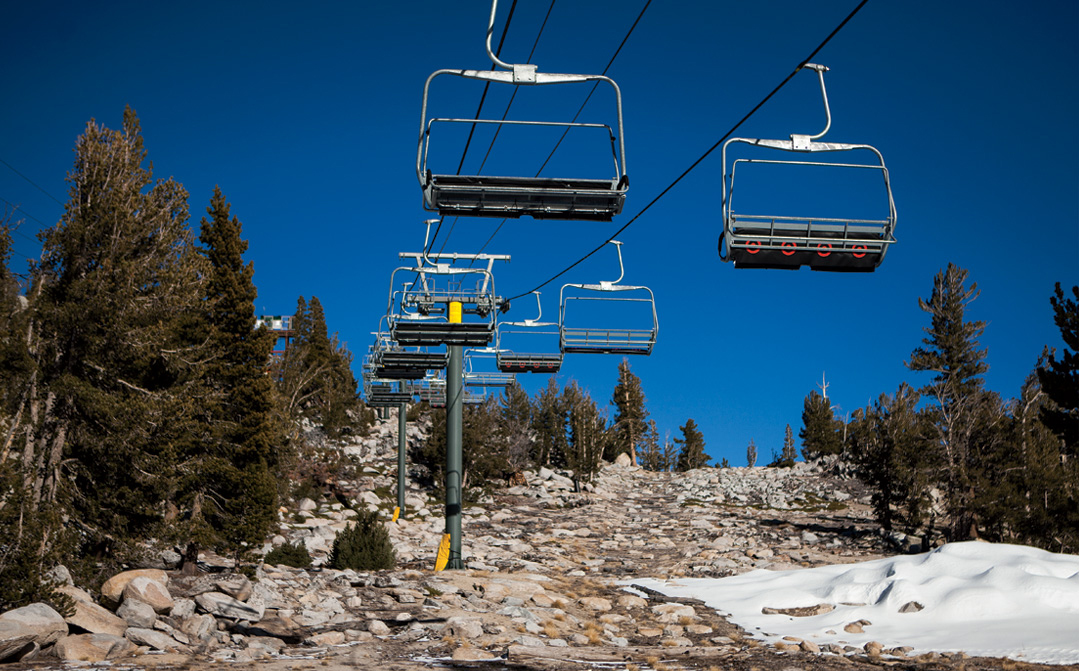
November 17, 2014: What a run at California’s Heavenly ski resort looks like without artificial snow.
Clifford Mann built the snowmaking system for California’s Mammoth Mountain from the ground up in 1991. He remembers Mammoth’s founder, Dave McCoy, looking out his window at barren slopes and saying, “You know, why don’t you go put some pipe out there and have some fun?”
Today, Mann has the resources to deposit snow on 600 acres of Mammoth’s lava rock, from the bunny slopes to the Cornice Bowl at the top of the mountain. His hard-working crew of 40 snowmakers labor through the night, attaching hoses and guns to water and air hydrants housed in a network of over 1,000 utility boxes.
Where does Mammoth get its water, and how much does it use? “I don’t talk about water,” Mann says, referring me to the marketing department. Why? “Because everybody believes it’s theirs.” Water is indeed a touchy subject—especially in drought-plagued California. Researcher Scott told me that he regularly asks ski resort operators for water data to use in his model, but they refuse him 9 times out of 10.
But anyone can estimate a ski resort’s snowmaking water use, mainly because resorts are proud of their snowmaking capacity and are keen to share statistics as a form of marketing: amounts of snow produced in an hour and number of acres served. All you need to know is the magic number used by the industry—180,000. That’s how many gallons it takes to cover an acre of bare land with one foot of artificial snow.
So if you read that Southern California’s little Snow Summit, which borders Big Bear Lake in the San Bernardino Mountains, routinely covers its 240 skiable acres with three to five feet of machine-made snow, you know that it uses somewhere between 130 million to 216 million gallons of water a season. Vail Resorts' annual report says that in the 2013 to 2014 season it used 150 millions gallons of water, most of it from underground, to make snow on 317 of its 4,800 acres of skiable terrain at California’s Heavenly resort. Because of intermittent rain on snow and mid-season thaws, big New England resorts like Maine’s Sunday River (“The Most Dependable Snow in New England”) use even more water per skier. In a resort-heavy region such as Lake Tahoe, snowmaking could conceivably account for nearly a billion gallons of freshwater used in a dry season. With warming temperatures, the industry will lean heavily on its water sources—and water rights—as rain and warm temps denude slopes of their manmade and natural snow. Last year’s California drought rendered snowmaking impracticable for some resorts, forcing them to close early.
These volumes seem enormous, but ski area managers and even some snow hydrologists note that most of the water returns to the watershed from which it was drawn. A Colorado study in the late 1980s found a reabsorption rate of 77 percent to 93 percent in the six sites studied. The remainder is lost to the atmosphere through sublimation, evaporation, and wind transport, while an unknown quantity of water escapes directly from a snow gun’s nozzle. (I was unable to find a peer-reviewed study examining the water consumption of snowmaking during the past warm decade.)
Lately, industry players have launched a concerted effort to clean up their act, mainly by converting to energy-efficient guns and making snow only during the most propitious weather windows. Some resorts use a higher percentage of renewable energy, like those in Ontario (thanks to the province’s 10-year plan to wean itself from coal-burning power plants).
But ski insiders know that their industry is living on borrowed time. “Snowmaking isn’t going to be our savior,” says Aspen’s Kaplan. “It might get us through some tougher seasons in a better position than we would be in. But 2°C, 3°C, 4°C—those are real problems, right? They’re telling us that by the end of the century, we’ll be growing piñon pines on top of the Highland Bowl. If that’s the scale and scope of the problem, snowmaking isn’t going to do us much good.”
 The Magazine of The Sierra Club
The Magazine of The Sierra Club
